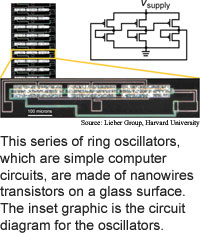
Nanowire computer circuits debut
One of the big challenges to making cheap,
lightweight, flexible electronic devices is developing simple, low-temperature
methods of making high-performance circuits.
Researchers from Harvard University have found a way to paint
molecular-size circuitry onto glass. The method is potentially very low-cost,
and could eventually be used to make computer chips that pack extremely
tiny and thus powerful circuits.
Because the tiny circuits can be painted on a non-crystalline
substrate like glass or plastic, they could eventually be used in flexible
electronic paper displays. Because the method is potentially inexpensive,
the circuits are also appropriate for low-cost radio frequency tags, according
to the researchers.
The researchers' prototype is a set of ring-oscillator circuits
painted on glass. Ring oscillators are basic computer circuits. They convert
direct current to alternating current via a self-sustaining feedback loop.
The circuits run at 10 megahertz, or 10 million cycles per second. This
is slower than silicon computer chips but faster than the plastic and
non-crystalline silicon used in flexible electronics today, according
to the researchers.
The circuits also have the potential to run in the gigahertz,
or billions of cycles per second, range of telecommunications equipment,
according to the researchers.
The roadblock to putting traditional electronics on glass or plastic
is that these substrates break down at the high temperatures used to make
crystalline silicon components.
The researchers made the circuits by flowing semiconductor nanowires
into position on an insulating layer on a glass substrate. The nanowires
serve as the channels, or signal carriers, all the device's transistors.
Using the method in practical applications requires making larger,
more complex circuits than the researchers' proof-of-concept prototype.
Practical applications could be possible within five years, according
to the researchers.
The work appeared in the April 28, 2005 issue of Nature
(High-Speed Integrated Nanowire Circuits).
Stories:
Robot runs like humans
DNA machine links molecules
Process ups biodiesel efficiency
How It Works: Power sources
Briefs:
Nanowire computer circuits debut
Lens boosts LED efficiency
Quantum crypto boosted to 2 GHz
Single camera measures speed

Research Watch blog
View from the High Ground Q&A
How It Works
RSS Feeds:
News
Ad links:
Buy an ad link
Ad links: Clear History
Buy an ad link
|
TRN
Newswire and Headline Feeds for Web sites
|
© Copyright Technology Research News, LLC 2000-2010. All rights reserved.